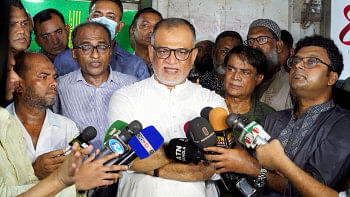Microcredit's Grameen rate of interest
It is often said that the financing charges, in the form of interest, as applicable to microcredit operations, including that levied by Grameen Bank in Bangladesh and elsewhere, are high compared to the prevailing interest rate in the conventional market. At the same time, overall experience gained suggests that microcredit business continues to be popular and there is strong public demand for additional coverage.
It needs to be recognised, however, that the financing charge in the form of interest seems to have unique but divergent response and operational outcome from the two distinctly different markets. In the conventional market in Bangladesh, until recently, prevailing rate of interest was in the range of 12-14 percent; in some countries it was in single digit. While the rate applicable to a microcredit borrower, in Bangladesh, Grameen Bank had deliberately kept it low, allowing its rate of interest charges at about 20 percent, for early removal of poverty. At the other end of the spectrum, Banco Compartamos in Mexico charged as high as 70 percent, arguing in favour of capital formation and early wider coverage.
Almost in all other countries, microcredit charges are alleged to be relatively high with a common 'outcry' of 'high interest' impeding poverty reduction. But everywhere, recovery rate has been high. Grameen Bank experienced 99 percent recovery. Even in strife-torn Afghanistan, Brac has had a successful microcredit operations experiencing relatively high rate of recovery.
In view of high rate of return in microcredit operations, lenders in Bangladesh, India and Mexico have been charging relatively 'very high interest' rate. Entertaining this perception of 'high interest' and for protecting the poor, Bangladesh Bank has capped the rate of interest applicable to microcredit operation at 27 percent. The Economist (November 20, 2012), seemed to have questioned the wisdom of such a move, suggesting that such a step may "deter new entrants (lenders) and reduce competition". In other words, it apparently argued that an unrestricted rise of interest could be justified if the relevant (mc) market would bear it, even though the clients were poor, seeking redress from poverty.
The experience of micro-lending at the so-called 'high interest' but experiencing, at the same time, a high recovery rate, and in view of the Economist's recent observations, effectively supporting an undeterred move towards a higher rate, lend one to ask if interest in the conventional market and the one for micro-lending are in fact two different products, in terms of cost consequence and operational outcome. Answers to these may help establish the fact that financing charge, called interest, applicable to microcredit operations is essentially a variant of conventional market interest, a distinctly different product, hence, logically, should be called differently. By way of name giving, it may be called "Grameen rate of interest" – 'gi', thereby help defining it more accurately, with the world already familiar with 'Grameen'.
The apparent main difference between the two markets seems to be in conditions laid for lending. In conventional market the borrower's main conditions are provision for collateral and penalty on default. In reality, recovery rate is frequently sluggish. Whereas, in microcredit market, there is no collateral and the recovery rate, universally, is very high.
However, the real difference, one is likely to argue, is in the respective outcome, in terms of returns to investment, in project performance, one under conventional market conditions and the other under microcredit operations. Commercial lending rate normally reflects the prevailing discount rate -- a proxy for the opportunity cost of the capital -- which also reflects the minimum expected rate of return for the entrepreneur. Whereas in the conventional market a rate of return in the order of 20-30 percent is acceptable, given the prevailing interest rate; in case of a microcredit operation frequently it exceeds 100 percent, raison d'etre for its popularity and its high rate of recovery. No wonder that the outcry of 'high interest' in a microcredit operation is not from the borrowers themselves.
In view of all these, she (frequently a woman in Bangladesh) cannot said to be operating in a conventional market. Also it can be argued that Grameen Bank's financing charge, although called interest, is not the market rate of interest in form, structure or in its financial consequence. Then, is not her payment of 'interest' a misnomer for some other form of financing charge, such as 'grameen interest', in her real world ('grameen market'). The two markets are distinctly different in the scale of their undertakings, source of customer response, and the rate of profitability. In any case, the interest charge she is liable to pay is of a distinctively different kind -- it's another variant. It could more meaningfully be called "Grameen rate of interest" (gi), thus allowing potentially a fresh thought, perhaps introducing a new concept, in the area of microcredit operation, globally.
The writer is a retiree of World Bank and Islamic Development Bank. He can be reached at [email protected].

 For all latest news, follow The Daily Star's Google News channel.
For all latest news, follow The Daily Star's Google News channel. 



Comments